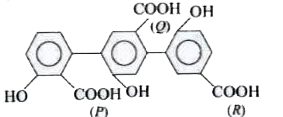The of monobasic acid and R are and respectively. The concentrations of P, Q and R are respectively
0.1M, 0.01 M and 0.001 M .
Q. Which acid has the minimum pH?
P
Q
R
All have equal pH
The correct Answer is:A
To determine which acid (P, Q, or R) has the minimum pH, we need to analyze the given information about their dissociation constants (K_a) and concentrations.
1. Identify the given values:
- For acid P: Ka=10−6 and concentration = 0.1 M
- For acid Q: Ka=10−8 and concentration = 0.01 M
- For acid R: Ka=10−10 and concentration = 0.001 M
2. Understand the relationship between Ka and acidity:
- The larger the Ka, the stronger the acid, which means it dissociates more in solution and produces more hydrogen ions (H+).
- Therefore, the acid with the highest Ka will have the lowest pH.
3. Calculate the concentration of H+ ions for each acid:
- For a weak acid, the dissociation can be represented as:
HA⇌H++A−
The expression for Ka is:
Ka=(H+)(A−)(HA)
- Assuming x is the concentration of H+ produced, we can write:
Ka=x2(HA)−x≈x2(HA)(for weak acids, where x is small compared to (HA))
4. Calculate H+ concentration for each acid:
- For acid P:
Ka=10−6=x20.1⟹x2=10−6×0.1=10−7⟹x=10−3M
- For acid Q:
Ka=10−8=x20.01⟹x2=10−8×0.01=10−10⟹x=10−5M
- For acid R:
Ka=10−10=x20.001⟹x2=10−10×0.001=10−13⟹x=10−6.5M
5. Determine the pH for each acid:
- pH is calculated using the formula:
pH=−log(H+)
- For acid P:
pH=−log(10−3)=3
- For acid Q:
pH=−log(10−5)=5
- For acid R:
pH=−log(10−6.5)≈6.5
6. Compare the pH values:
- pH of P = 3
- pH of Q = 5
- pH of R ≈ 6.5
7. Conclusion:
- The acid with the minimum pH is acid P, which has the highest Ka value.
Final Answer:
Acid P has the minimum pH.
- For acid P: Ka=10−6 and concentration = 0.1 M
- For acid Q: Ka=10−8 and concentration = 0.01 M
- For acid R: Ka=10−10 and concentration = 0.001 M
- The larger the Ka, the stronger the acid, which means it dissociates more in solution and produces more hydrogen ions (H+).
- Therefore, the acid with the highest Ka will have the lowest pH.
- For a weak acid, the dissociation can be represented as:
HA⇌H++A−
The expression for Ka is:
Ka=(H+)(A−)(HA)
- Assuming x is the concentration of H+ produced, we can write:
Ka=x2(HA)−x≈x2(HA)(for weak acids, where x is small compared to (HA))
- For acid P:
Ka=10−6=x20.1⟹x2=10−6×0.1=10−7⟹x=10−3M
- For acid Q:
Ka=10−8=x20.01⟹x2=10−8×0.01=10−10⟹x=10−5M
- For acid R:
Ka=10−10=x20.001⟹x2=10−10×0.001=10−13⟹x=10−6.5M
- pH is calculated using the formula:
pH=−log(H+)
- For acid P:
pH=−log(10−3)=3
- For acid Q:
pH=−log(10−5)=5
- For acid R:
pH=−log(10−6.5)≈6.5
- pH of P = 3
- pH of Q = 5
- pH of R ≈ 6.5
- The acid with the minimum pH is acid P, which has the highest Ka value.
Acid P has the minimum pH.
Topper's Solved these Questions
- TEST PAPERSBOOK - RESONANCE ENGLISHCHAPTER - TEST PAPERSEXERCISE - PT-01
30 Videos
- TEST PAPERSBOOK - RESONANCE ENGLISHCHAPTER - TEST PAPERSEXERCISE - Pt-02
30 Videos
- TEST PAPERSBOOK - RESONANCE ENGLISHCHAPTER - TEST PAPERSEXERCISE - PART - III CHEMISTRY
20 Videos
- SURFACE CHEMISTRYBOOK - RESONANCE ENGLISHCHAPTER - SURFACE CHEMISTRYEXERCISE - Section - 5
1 Videos
- TEST SERIESBOOK - RESONANCE ENGLISHCHAPTER - TEST SERIESEXERCISE - CHEMISTRY
50 Videos
Similar Questions
The Ka of monobasic acid P,Q and R are 10−6,10−8 and 10−10 respectively.
The concentrations of P, Q and R are respectively
0.1M, 0.01 M and 0.001 M .
Q. Which of the following is true?
View SolutionThe dissociation constant of monobasic acids A.B and C are 10−4,10−6and10−10 respectively, The concentration of each monobasic acid is 0.1 M Which of the following has been arranged in increasing order of pH ?
View Solution
Knowledge Check

The correct acidic strength order of acidic hydrogen P, Q and R is respectively :AP>Q>RBP>R>QCR>Q>PDQ>R>P
At certain temperature, dissociation constant of formic acid and acetic acid are 1.8×10−4 and 1.8×10−5 respectively. At what concentration of acetic solution, the H3O+ ion concentration is same as that in 0.001 M formic acid solution
View SolutionThe dissociation constant of monobasic acids A,B,C and D are 6×10−4,5×10−5,3.6×10−6, and 7×10−10, respectively. The pH values of their 0.1M aqueous solutions are in the order.
View SolutionThe dissociation constants of m-nitrobenzoic acid and acetic acid are 36.0×10−5 and 1.8×10−5 respectively. What are their relative strengths?
View SolutionK1 & K2 for oxalic acid are 6.5×10−2 and 6.1×10−5 respectively . What will be the [OH−] in a 0.01M solution of sodium oxalate
View SolutionKa for monobasic acid ,whose 0.1M solution has pH of 4.5 is :
View SolutionThe dessociation cosntants of acetic acid and propionic acid are 1.0×10−5 and 1.0×10−6 respectively. The value of PKa (propionic acid) - PKa (Acetic acid) is
View SolutionpH of a strong diprotic acid (H2A) at concentrations:
(i) 10−4 M, (ii) 10−4 N
are respectively:
View Solution
